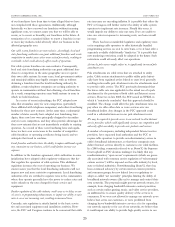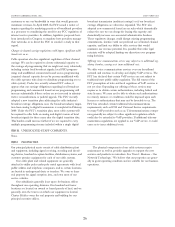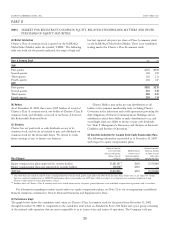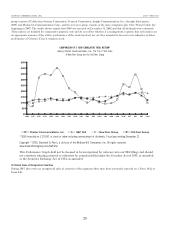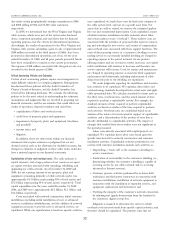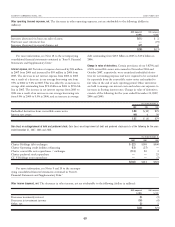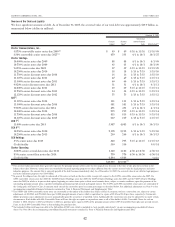Charter 2007 Annual Report Download - page 45
Download and view the complete annual report
Please find page 45 of the 2007 Charter annual report below. You can navigate through the pages in the report by either clicking on the pages listed below, or by using the keyword search tool below to find specific information within the annual report.
Under both SFAS No. 144 and SFAS No. 142, if an asset is
determined to be impaired, it is required to be written down to
its estimated fair market value. We determine fair market value
based on estimated discounted future cash flows, using reason-
able and appropriate assumptions that are consistent with inter-
nal forecasts. Our assumptions include these and other factors:
Penetration rates for analog and digital video, high-speed Inter-
net, and telephone; revenue growth rates; and expected operating
margins and capital expenditures. Considerable management
judgment is necessary to estimate future cash flows, and such
estimates include inherent uncertainties, including those relating
to the timing and amount of future cash flows, and the discount
rate used in the calculation.
Franchises were aggregated into essentially inseparable asset
groups to conduct the valuations. The asset groups generally
represent geographic clustering of our cable systems into groups
by which such systems are managed. Management believes such
groupings represent the highest and best use of those assets.
Our valuations, which are based on the present value of
projected after tax cash flows, result in a value of property, plant
and equipment, franchises, customer relationships, and our total
entity value. The value of goodwill is the difference between the
total entity value and amounts assigned to the other assets. The
use of different valuation assumptions or definitions of franchises
or customer relationships, such as our inclusion of the value of
selling additional services to our current customers within cus-
tomer relationships versus franchises, could significantly impact
our valuations and any resulting impairment.
Franchises, for valuation purposes, are defined as the future
economic benefits of the right to solicit and service potential
customers (customer marketing rights), and the right to deploy
and market new services (service marketing rights). Fair value is
determined based on estimated discounted future cash flows
using assumptions consistent with internal forecasts. The fran-
chise after-tax cash flow is calculated as the after-tax cash flow
generated by the potential customers obtained (less the antici-
pated customer churn) and the new services added to those
customers in future periods. The sum of the present value of the
franchises’ after-tax cash flow in years 1 through 10 and the
continuing value of the after-tax cash flow beyond year 10 yields
the fair value of the franchise.
Customer relationships, for valuation purposes, represent the
value of the business relationship with our existing customers
(less the anticipated customer churn), and are calculated by
projecting future after-tax cash flows from these customers,
including the right to deploy and market additional services to
these customers. The present value of these after-tax cash flows
yields the fair value of the customer relationships. Substantially
all our acquisitions occurred prior to January 1, 2002. We did not
record any value associated with the customer relationship
intangibles related to those acquisitions. For acquisitions subse-
quent to January 1, 2002, we did assign a value to the customer
relationship intangible, which is amortized over its estimated
useful life.
Our impairment assessment as of October 1, 2007 did not
indicate impairment; however upon completion of our 2008
budgeting process in December 2007, we determined that a
triggering event requiring a reassessment of franchise values had
occurred. Largely driven by increased competition being experi-
enced by us and our peers, we lowered our projected revenue
and expense growth rates and increased our projected capital
expenditures, and accordingly revised our estimates of future cash
flows as compared to those used in prior valuations. See “Item 1.
Business – Competition.” As a result, we recorded $178 million of
impairment for the year ended December 31, 2007.
The valuations completed at October 1, 2006 and 2005
showed franchise values in excess of book value, and thus
resulted in no impairments.
The valuations used in our impairment assessments involve
numerous assumptions as noted above. While economic condi-
tions, applicable at the time of the valuation, indicate the
combination of assumptions utilized in the valuations are reason-
able, as market conditions change so will the assumptions, with a
resulting impact on the valuation and consequently the potential
impairment charge. At December 31, 2007, a 10% and 5% decline
in the estimated fair value of our franchise assets in each of our
asset groupings would have increased our impairment charge by
approximately $840 million and $390 million, respectively. A
10% and 5% increase in the estimated fair value of our franchise
assets in each of our asset groupings would have reduced our
impairment charge by approximately $178 million and $90 mil-
lion, respectively.
Income Taxes. All operations are held through Charter Holdco
and its direct and indirect subsidiaries. Charter Holdco and the
majority of its subsidiaries are generally limited liability compa-
nies that are not subject to income tax. However, certain of these
limited liability companies are subject to state income tax. In
addition, the subsidiaries that are corporations are subject to
federal and state income tax. All of the remaining taxable
income, gains, losses, deductions and credits of Charter Holdco
are passed through to its members: Charter, CII and Vulcan
Cable. Charter is responsible for its share of taxable income or
loss of Charter Holdco allocated to it in accordance with the
Charter Holdco limited liability company agreement (“LLC
Agreement”) and partnership tax rules and regulations.
The LLC Agreement provides for certain special allocations
of net tax profits and net tax losses (such net tax profits and net
tax losses being determined under the applicable federal income
tax rules for determining capital accounts). Under the LLC
Agreement, through the end of 2003, net tax losses of Charter
Holdco that would otherwise have been allocated to Charter
based generally on its percentage ownership of outstanding
common units were allocated instead to membership units held
by Vulcan Cable and CII (the “Special Loss Allocations”) to the
extent of their respective capital account balances. After 2003,
under the LLC Agreement, net tax losses of Charter Holdco
were allocated to Charter, Vulcan Cable and CII based generally
on their respective percentage ownership of outstanding com-
mon units to the extent of their respective capital account
balances. Allocations of net tax losses in excess of the members’
aggregate capital account balances are allocated under the rules
34
CHARTER COMMUNICATIONS, INC. 2007 FORM 10-K



